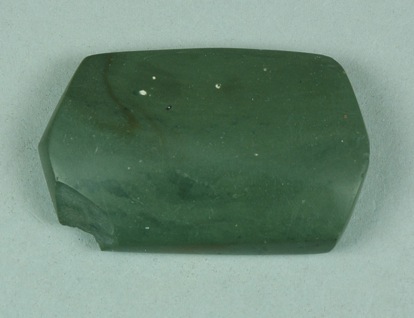Greenstone ‘heart’
Aztec people, Puebla, Mexico
 Donated by Zelia Nuttall in 1905; 1905.56.1Jade was a revered stone among the cultures of Pre-Columbian Mesoamerica because it was only found in one place – the Moraga Valley in Guatemala. For the people of Mexico (who referred to themselves as Mexica and whom we know as 'Aztecs') it was more valuable than gold. By law only the nobility could own or wear jade. Jade and other 'greenstones' such as jadeite, serpentine or emerald were highly symbolic because their green colour was associated with the life-giving power of water and unripened crops. For this reason they were often used in the performance of rituals.
Donated by Zelia Nuttall in 1905; 1905.56.1Jade was a revered stone among the cultures of Pre-Columbian Mesoamerica because it was only found in one place – the Moraga Valley in Guatemala. For the people of Mexico (who referred to themselves as Mexica and whom we know as 'Aztecs') it was more valuable than gold. By law only the nobility could own or wear jade. Jade and other 'greenstones' such as jadeite, serpentine or emerald were highly symbolic because their green colour was associated with the life-giving power of water and unripened crops. For this reason they were often used in the performance of rituals.
This piece of jade has been carved and ground smooth with a hand-tool of haematite. It is said that it was worn as a pendant in life, then placed in the mouth of the owner upon their death. Jade beads and pendants have been found in the mouths of both Maya and later Aztec corpses. Since jade was associated with life it was thought that placing it over the mouth at the time of the last exhaled breath would capture the essence of that person forever in the stone. Jade stones like this have been found in graves alongside other jade votive objects such as necklaces, earrings and figurines.
The passage of time, death and the afterlife were important ideas for the Maya and Aztec people, who lived according to a calendar of 52-year cycles, at the end of which they would wait anxiously to see if the gods would be benevolent enough to grant them another cycle of life.
Aztec burials were essentially the same for all members of society, with special attention paid to the burials of nobles and rulers as well as women who died in childbirth. The dead were dressed for their funeral (either by burial or cremation) in a manner befitting their position in life or the circumstances of their death. For example a soldier might be dressed as Huitzilopochtli, the god of war, whereas someone who had died from excessive alcohol consumption might be adorned with the emblems of Tezcatzontecatl, the god of beer and wine. Since the person was returning to the 'womb of the Earth', they would be placed in the foetal position in the ground or on the pyre and a vase of water representing amniotic fluid was poured over them. After cremation the ashes, teeth and sometimes hair cuttings were placed in a jar together with a greenstone of a value proportionate to the wealth of the deceased. The jar was buried and the life-giving greenstone would serve the soul as a new heart in the new world in which they were about to enter.
When a lord or noble died, a similar if longer and more elaborate procedure ensued. The body was wrapped in a dozen or more fine cloaks to form a mummy bundle, a piece of jade or even emerald was placed on his lips, and his face concealed by a mask. The body was laid outside the temple for several days as neighbouring lords came to offer lavish gifts and food. After cremation, the jar containing the ashes and the emerald or jade stone was placed on the temple altar or in a special room in the royal palace. Human sacrifices were made before the jar at intervals up to a year, and animal and bird sacrifices up to four years, after which time it was finally buried and the greenstone could take on its new role as a 'heart'.
